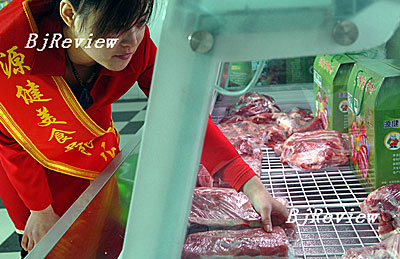|

"We will be facing fairly great price pressures in 2008," said Xie Fuzhan, Director of the National Bureau of Statistics (NBS), on January 24. "Even if there are no new factors causing price hikes, the inertia from the rises in 2007 is still devastating."
According to the NBS' 2007 national economic report, the growth rate of the consumer price index (CPI), a barometer for inflation, surged 4.8 percent, up 3.3 percentage points comparing with 2006.
The Chinese Government had already predicted that there would be a major rise in the CPI, and it set the 2007 CPI growth rate target at 3 percent, double that of 2006. Judging by the current situation, the 4.8-percent growth far outpaced the government estimation, which was the highest growth rate since 1997.
Xie was worried about the CPI, but denied there was inflation. He claimed the rising CPI growth rate had caused inflationary pressure, but not inflation itself.
Many government officials and scholars held the same opinion, and believed the 2008 CPI growth rate would be noticeable.
The trend
China encountered serious inflation in five consecutive years from 1992 to 1996, after which the CPI maintained at a stable level for 10 years. In 1998, 1999 and 2002, CPI growth was negative. Between 2003 and 2006, the economy performed well with high growth and low inflation.
However, this trend changed in 2007 as the CPI surged considerably.
Xie said there were many reasons for the 2007 CPI surge. Generally speaking, the abundant money supply, especially the broad money supply exceeding 40 trillion yuan ($5.55 trillion), was one of the major reasons for CPI growth.
The trigger in this round of CPI growth was the pork price surge. Starting from June 2007, stimulated by pork price rise, the CPI growth rate exceeded 4 percent. The pork price rise was largely because of the extremely low price of pork in 2006, which led to the decrease in the number of pigs, particularly female pigs, in stall. Meanwhile, blue ear disease and other contagious diseases also reduced pig numbers. Rising grain and feed prices also contributed to the pork price rise, eventually leading to the overall consumer price surge.
Xie said rising international primary product prices also added pressure to China's CPI surge. First of all, international oil prices kept increasing and exceeded $100 a barrel in 2007 from just $25 a barrel in 2003. "The considerable amount of oil imports helped push the domestic oil and other prices up," said Xie.
Xie said another factor was the rise of international edible oil price, which nearly doubled in 2007, while the growth of edible oil price in the domestic market was slower than that in the international market.
"The rising oil and edible oil prices are two major structural causes pushing consumer prices higher," said Xie.
| 